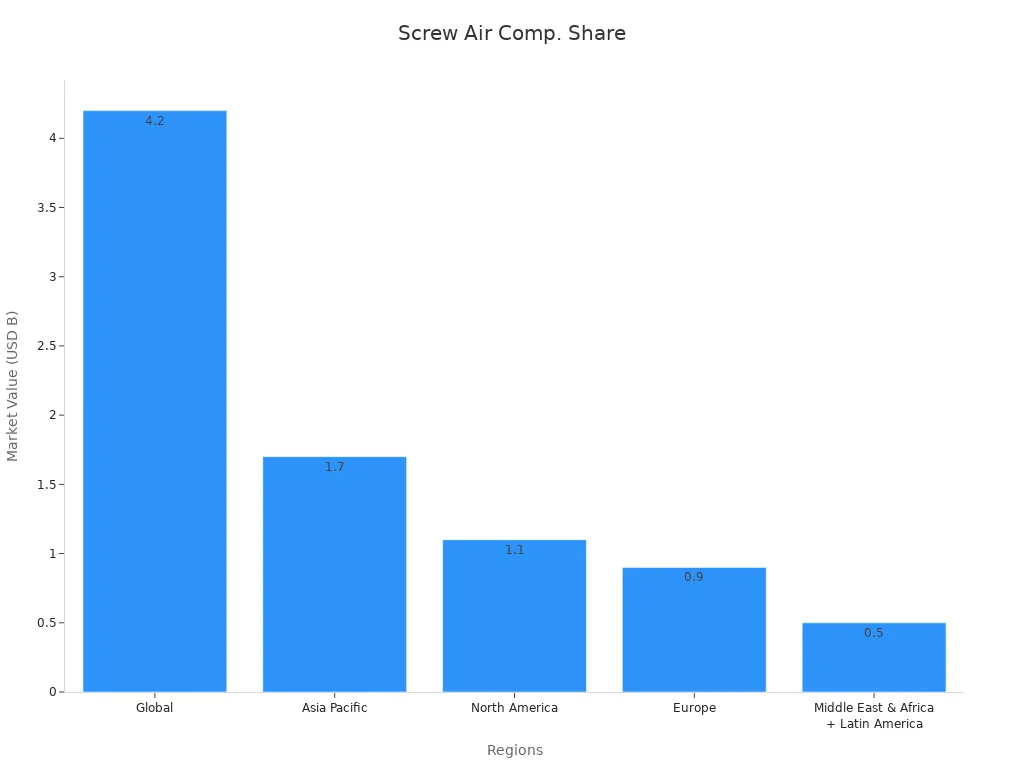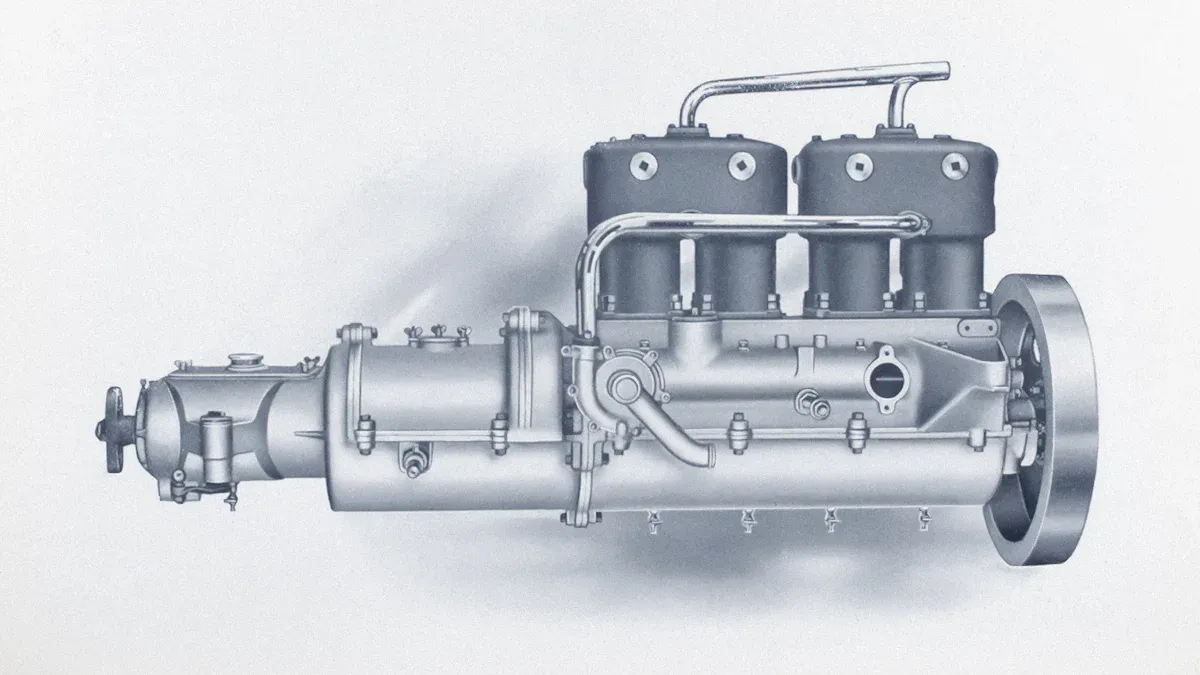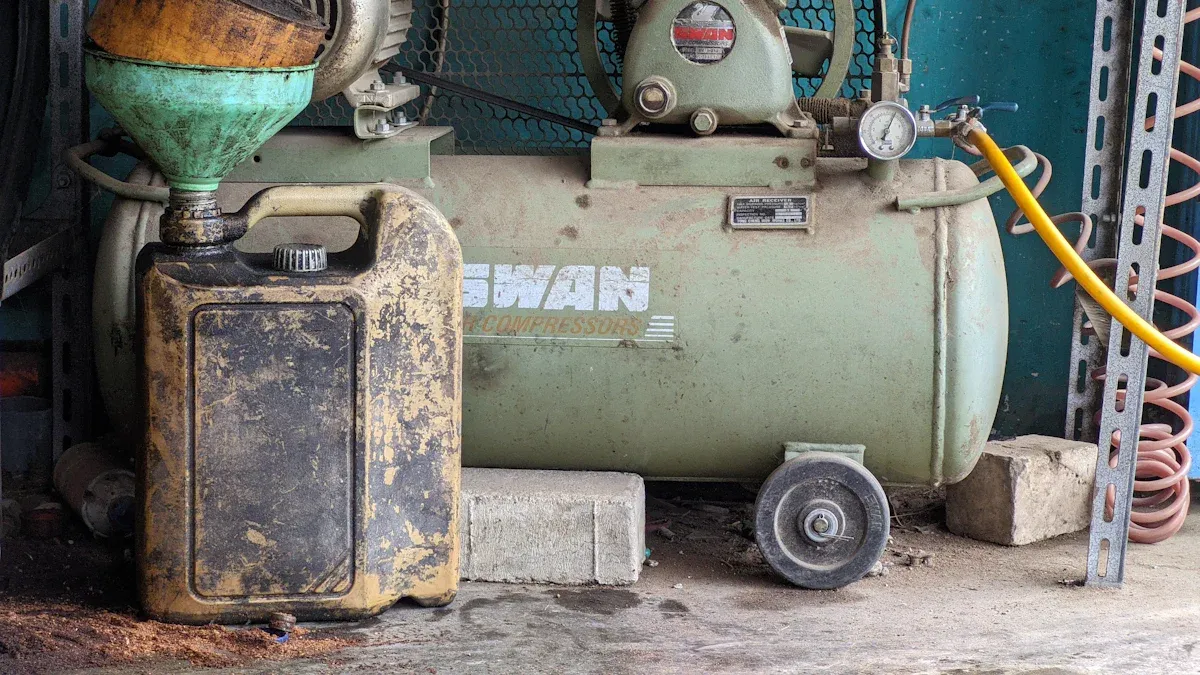Views: 0 Author: Site Editor Publish Time: 2025-07-08 Origin: Site











A screw air compressor has two screws that spin in opposite ways. These screws help push air together in a smart way. This kind of air compressor is very important in factories, building sites, and hospitals in 2025. Many companies use screw air compressors because they give steady air. They also do not break down often and are easy to take care of. The world market for these machines was $4.2 billion in 2024. Experts think the market will keep growing until 2033.


A screw air compressor is a kind of rotary-screw compressor. It uses two helical rotors to squeeze air. These machines are part of the positive-displacement group. This means they trap air and make it smaller to raise pressure. The screw compressor gives a steady stream of compressed air. Many industries pick this technology because it works all the time. It can handle tough places. Factories, hospitals, and building sites trust screw compressors for being reliable and efficient.
Note: The screw compressor is often picked first for jobs that need a steady flow of compressed air with no stops.
The rotary-screw compressor has two helical rotors inside a sealed chamber. These are called the male and female screws. They spin in opposite ways. When they turn, air comes in through an intake valve. The air fills the space between the rotors. The screws trap the air and push it along the chamber. As the space gets smaller, the air gets squeezed. This process does not use any valves. This lets the rotary screw air compressor run fast and with little shaking.
The design of the screws is very important. The male and female rotors have different shapes and grooves. Their movement is timed by outside gears. This keeps them from touching and lowers friction. This setup helps the screw compressor work well and stay quiet. Oil-injected rotary-screw compressors use oil inside the chamber. The oil helps cool, seal, and lower noise. Oil-free models use outside gears to keep the rotors apart. This makes them good for places that need clean air.
A rotary-screw compressor has many important parts that work together:
Rotors (Screws): These are the main parts. They spin and squeeze the air by making the space smaller.
Compressor Housing: This is the sealed box that holds the rotors and guides the air.
Intake Valve: This part controls how much air goes in.
Discharge Port: This is where the compressed air comes out.
Drive Motor: This part makes the screws spin.
Cooling System: This removes heat made during compression. It often uses cooling between stages to work better.
Lubrication System: This sends oil to important spots, especially in oil-injected models. It helps lower friction and makes the compressor last longer.
Control System: This gives different ways to control the compressor, like Load/Unload, Modulation, or Variable Speed, to match air needs.
Air/Oil Separator (for oil-injected models): This part takes oil out of the compressed air before it leaves.
Filtration System: This removes dirt from the air and oil to protect the inside parts.
Screw compressors are made to run all the time. They can work at a 100% duty cycle. This means they can keep going without getting too hot or breaking down fast. Many industries need this for jobs that use a lot of air. Some examples are:
Factories that need steady air for tools and machines
Hospitals that need clean, steady air for medical tools
Building sites that use compressed air for power tools
Food and drink factories that need oil-free air for safety
Tip: The NxHE Series and other models can run all the time. They have features like cooling between stages, separate oil for bearings, and air with no pulses. These things make them great for tough industrial jobs.
There are two main types of screw compressors. One is oil-injected, and the other is oil-free. Oil-injected models use oil to cool and seal the rotors. This helps the rotary-screw compressor work well and last longer. Many factories and workshops pick oil-injected screw compressors for hard jobs. These machines can handle high pressure and tough places.
Oil-free screw compressors do not use oil inside the chamber. They use special coatings and careful design instead. Hospitals, food plants, and electronics factories need clean air. They choose oil-free screw compressors to keep oil out of the air. This keeps equipment and products safe.
Note: Oil-injected screw compressors cost less to buy and fix. Oil-free models cost more but give cleaner air.
A rotary-screw compressor can have fixed speed or variable speed. Fixed speed models run at one speed all the time. They are good for jobs where air needs stay the same. Many small shops and simple air systems use fixed speed screw compressors.
Variable speed screw compressors can change their speed. They match the air needs and save energy. Big factories and plants with changing air needs use VSD screw compressors. These help lower power bills and reduce machine wear.
| Type | Best For | Energy Use |
|---|---|---|
| Fixed Speed | Steady air demand | Higher |
| Variable Speed | Changing air demand | Lower |
Screw compressors are used in many places. Factories use them to power tools and machines. Hospitals need them for medical air. Food and drink plants use them for clean air in packaging. Construction sites use screw compressors for drills and hammers. Gas compressor stations use rotary-screw compressor units to move gas in pipes. Oil refineries use screw compressors for process air and as a gas compressor.
Some screw compressors come with a tank for easy setup. Others have an air dryer built in to remove water. These features help users make a complete air compressor system.
Tip: Always check if a screw compressor has a built-in dryer or tank. These extras can save space and make care easier.
A screw compressor works well and is very reliable. Many companies use it because it can run all the time. It does not need to stop for breaks like piston compressors. This machine does not get too hot when running nonstop. The isentropic efficiency can be as high as 92% at full load. This is better than most piston compressors. The design helps it stay cooler and make less heat. These things help the machine last longer. A screw compressor gives more air for each horsepower. It gives about 4-5 cfm per hp, while piston types give 3-4 cfm per hp. This means people get more air and less downtime.
Many factories use screw compressors for nonstop work because they almost never break and need little care.
Saving energy is a big reason people buy screw compressors. Variable Speed Drive models can use up to 35% less energy than fixed-speed ones. Some factories have saved 30% on energy bills by using VSD screw compressors. This can save thousands of dollars every year. Lowering air pressure by 1 bar can save about 7% energy. When running at full load, a screw compressor uses energy better. Energy recovery systems can save up to 94% of used energy. These systems often pay for themselves in less than three years. Checking for leaks and fixing them also saves energy. Leaks can waste up to 25% of compressed air.
A screw compressor is much quieter than old piston models. Its rotary design makes less noise and vibration. This makes it good for indoor places or quiet areas. Many hospitals and labs pick screw compressors to keep things calm and safe. Less noise means workers feel less stress and complain less. The smooth running also keeps nearby equipment safe from shaking. This makes screw compressors a smart pick for places that want comfort and safety.

Today’s screw air compressors use smart controls. Makers put sensors in the machines. These sensors watch temperature, vibration, pressure, and humidity. The sensors send data to the control system right away. The compressor changes its settings by itself. This helps it run at the best speed for each job. Smart controls use AI and machine learning too. These tools guess when the compressor needs fixing. One factory had 40% less surprise downtime with smart controls. Another saved 15% on energy bills. These changes make screw compressors work better and break less.
Smart controls help companies stop costly breakdowns and keep things running well.
IoT means the Internet of Things. It links screw compressors to the internet. Companies add WiFi and smart controllers to their machines. These parts check pressure, temperature, flow, and energy use. Managers can see how the compressor works on their phones or computers. IoT systems find problems early and tell you to fix them. AI looks at the data to spot patterns and help the compressor work better. Real examples show big changes. A car company used 20% less energy. A drink plant made pressure more steady by 15%. A medicine site had 30% less surprise downtime. IoT makes compressors smarter and more connected.
Eco-friendly features are now very important for screw compressors. Companies check how well they work by looking at airflow, power use, and isentropic efficiency. Isentropic efficiency shows how much energy the compressor saves. The Compressed Air and Gas Institute (CAGI) tests these numbers. They put the results in CAGI Data Sheets so buyers can compare.
Isentropic efficiency tells how much energy a compressor saves at different pressures.
CAGI Data Sheets show info for many kinds of compressors, like lubricated and oil-free models.
Checked data helps buyers pick machines that use less energy and make less pollution.
These eco-friendly changes help companies save money and protect the earth.
Picking the right screw air compressor takes planning. Companies need to match the machine to how much air they use now and later. The table below shows what to think about and some good tips:
| Selection Aspect | Considerations & Best Practices |
|---|---|
| Airflow (CFM) | Add up all tool needs at once. Add 25-30% more for leaks and future growth. |
| Pressure (PSI) | Match what your tools need. Add 10-15 PSI extra for drops. |
| Power Rating (HP/kW) | Pick the power you need. Think about saving energy. Choices go from 5 HP to 500 HP. |
| Cooling System | Use air-cooled for most jobs. Pick water-cooled for tight or tough spots. You can reuse heat too. |
| Control Systems | Smart controls and VSD save energy and help the compressor work better. |
| Maintenance & TCO | Plan for regular checks and service. Count energy costs in the total price. |
| Compressor Stages | Single-stage is for light jobs. Two-stage is for hard, nonstop, or high-pressure work. |
| Environmental Factors | Think about room temperature, space, noise, and airflow. |
| Air Quality | Oil-free air is needed for medical, food, or drug jobs. Pick the right one. |
Follow these steps to get the best fit:
Pick a compressor that meets your pressure and airflow needs. Think about height and temperature too.
Check air quality needs with ISO 8573-1 rules. Class 0 or 1 is best for oil-free jobs.
Look at how often you use air. Count shifts and backup needs to pick the right size and number.
Think about the room, cooling, and space you have.
Size the compressor for the busiest time. Add extra for growth.
Choose single-stage or two-stage based on pressure and job type.
Plan when to do checks and count all costs for long-term use.
Tip: Make sure the compressor can handle your biggest air use, not just the average.
When picking a brand, companies want machines that last and have good help. Kaeser, Atlas Copco, Sullair, and Chicago Pneumatic (CP) are known for quality. Some brands like Compair/LeRoi have worked almost 66,000 hours with few problems. Cheaper or unknown brands may break more or have bad support. Always check the warranty, service help, and what other buyers say before buying.
Doing regular checks keeps screw air compressors working well and lasting longer. Top brands say to check often and make sure parts are easy to reach. These jobs help the compressor run its best:
Change air and oil filters when the maker says.
Check and change oil as needed, especially for oil-injected types.
Look at belts for wear and fix if loose.
Clean the cooling system and make sure air can flow.
Drain water from tanks and dryers to stop rust.
Listen for strange sounds or shaking, which could mean trouble.
Kaeser compressors need service every 2,000 hours and are quiet and steady. Atlas Copco may need a new thermostat every 8,000 hours and oil changes. Chicago Pneumatic often just needs oil and filter changes. Some other brands may break down more.
Note: Easy-to-reach parts and good service help cut downtime and keep things running.
Even the best screw air compressors can have problems sometimes. Fixing issues fast stops long delays. Here are some common problems and fixes:
Low Pressure Output: Look for leaks, dirty filters, or worn valves.
Excessive Noise or Vibration: Check bearings, belts, and bolts.
Oil Leaks: Look at seals and gaskets. Replace if broken.
Overheating: Clean the cooling system and check for blocked air.
Frequent Shutdowns: Check control settings and safety switches.
Kaeser reports 8,400 hours of work with no problems if cared for. Atlas Copco may have control board or oil leak issues, but warranty fixes help. Picking a good brand with strong support means faster fixes and less waiting.
If you still have trouble, call a trained technician to stop more damage.
Owning a screw air compressor costs more than just buying it. Companies should think about:
Initial Investment: Top brands cost more at first but last longer.
Energy Consumption: VSD and smart controls can cut energy bills by up to 35%.
Maintenance Costs: Regular checks and easy parts lower long-term costs.
Downtime: Good brands mean less lost work time.
Warranty and Support: Good warranties and help add value.
A good compressor saves money over time by using less energy and breaking less. Buying a trusted brand with a good record often means lower total costs.
Screw air compressors in 2025 work well and save energy. They also have smart features that help users. It is important to know about oil-injected and oil-free models. Regular care helps the machines last longer and run better. Every business should check how much air it needs. They should also look at different brands that people trust.
To get the best results, talk to an expert or ask for a demo before you buy. Planning ahead helps you save money and work more efficiently.
Oil-injected models use oil to cool and seal parts. Oil-free compressors do not use oil inside the chamber. Hospitals and food plants pick oil-free types when they need clean air.
Most brands say to check filters, oil, and belts every 2,000 hours. Some machines might need service even sooner. Taking care of the compressor often stops breakdowns and keeps it working well.
Yes. Screw air compressors can run all the time without stopping. They work in factories, hospitals, and building sites without getting too hot or needing lots of breaks.
A business should add up how much air all tools use. Then add 25% more for leaks and future needs. Picking the right size gives steady air and saves energy.
Smart controls help lower downtime and save energy. They watch how the compressor works, find problems early, and change settings by themselves. Many companies pay less for energy and repairs with these features.